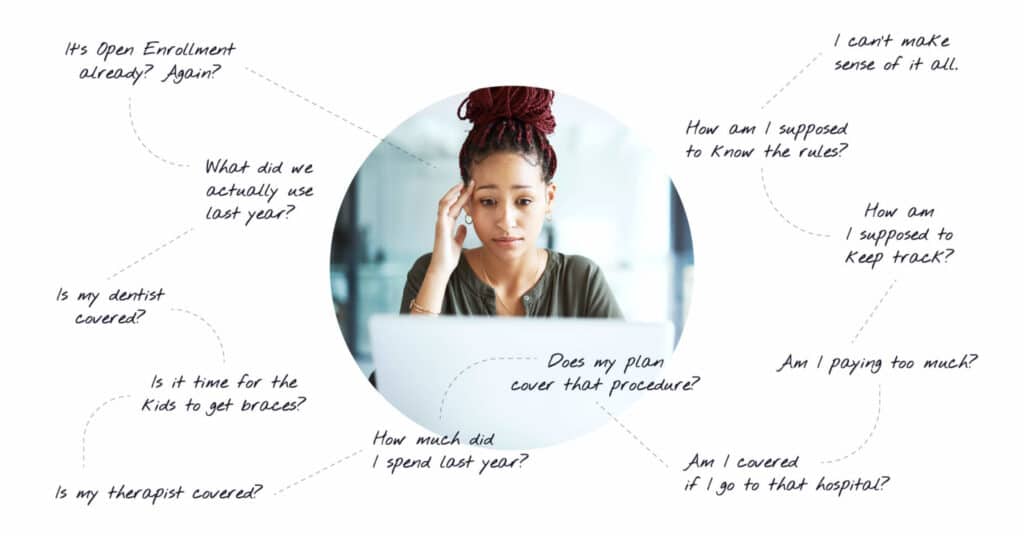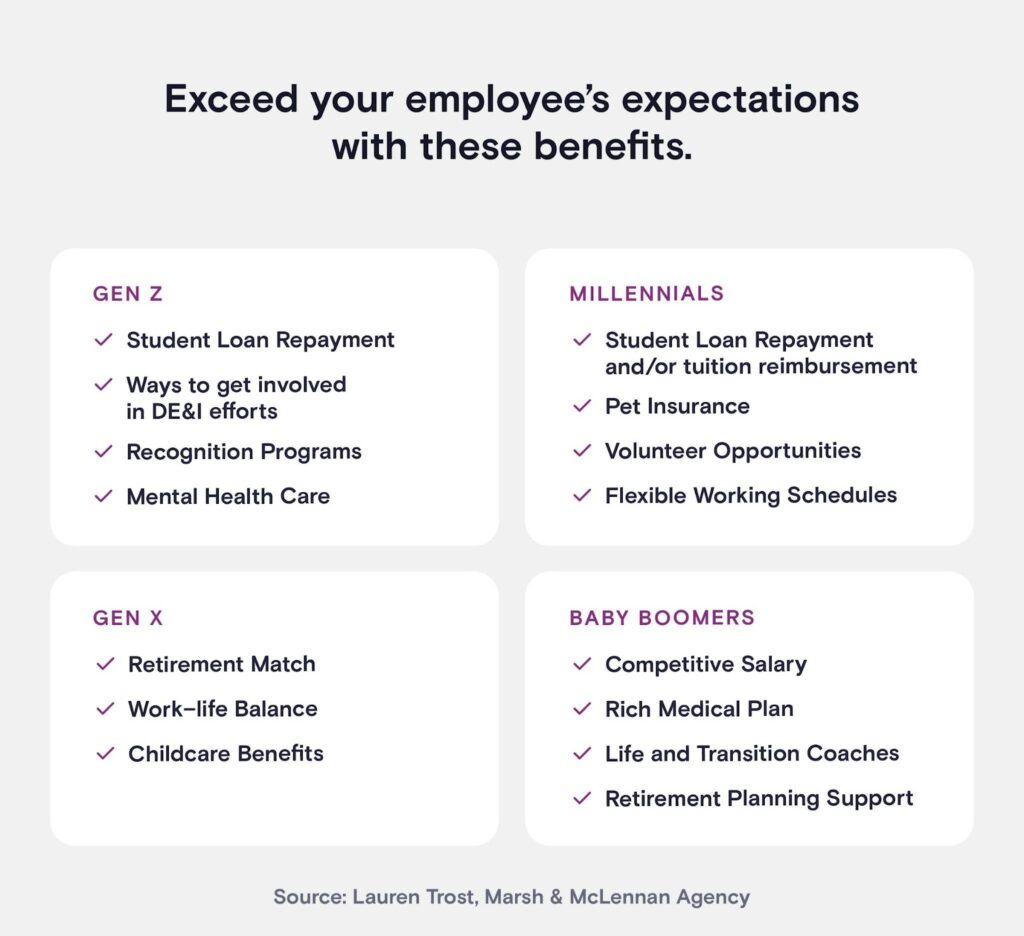Benefits pros, there’s no denying it. The last three years have felt like a complete roller coaster. From pandemic panic to The Great Resignation to “quiet quitting,” you’ve had to pivot countless times to keep your employees happy, healthy, and engaged. And as we head into 2023, we’re faced with a sobering reality: the ride’s not quite over yet.
Recession fears are driving hiring freezes, sweeping layoffs, and budget cuts. That means the benefits packages that you’ve worked so hard to curate might be taking a hit—and you’re left wondering how to make sure your employees have the resources they need, when they need it most.
While the look ahead might feel tough, know this: you and your team are more resilient than ever. You’ve proven over the last three years that you know how to charter unknown waters, take care of struggling employees, and change gears if you need to. So let’s prepare together, and take a look at the most important employee benefits trends and challenges we should know about as we head into 2023.
1. We’ve created a tangled web of benefits
In light of the many challenges employees are currently facing, a majority of Jellyvision customers told us they’ve expanded their benefits packages in the last three years. From a bigger focus on mental health and telemedicine to non-traditional perks like home office stipends and pet insurance, employers are bolstering their total rewards offerings to better support a modern workforce and attract talent in a tumultuous job market.
And that’s a great thing! But it also creates a new problem: we’ve created a tangled web of benefits that are incredibly difficult for employees to navigate.

With so many options to choose from, employees face an incredible amount of benefits decision fatigue. And we don’t make it any easier on them by giving them a 30-page benefits guide to sift through or hiding jargon-filled healthcare one-pagers on our Intranet.
In other words, we’re giving employees access to every possible benefit they could ever need, without giving them any guidance as to which ones are most helpful and cost-effective for them. And that’s an expensive mistake:
So if your total rewards package is bigger than it used to be, make sure benefits communication is a priority as you’re building your HR strategies for the year.
2. Employees don’t feel connected to your benefits
Ultimately, providing a great benefits package is about strengthening our relationships with employees. By caring for our workforce as people first, we’re creating human connections with the people who work for us.
But when it comes to how we communicate benefits, there’s often a disconnect. With so many options to choose from, employees end up feeling like none of your benefits are the right fit for them—because they don’t know which ones they actually need, and how much it’s going to cost them. And when employees don’t feel connected to the resources you’re providing, they don’t feel connected to you, their employer—and your benefits investment goes to waste.
Last year, we asked employees across the US how they’d most like to learn about the benefits available to them. Their response? They want to talk to you (yes, you!):
And that makes sense, right? Healthcare is complicated and incredibly personal. Your employees know and trust your HR team, and they want to feel connected to you as their employer. They’re actively seeking out personalized, expert advice that will help them understand the benefits landscape and get the best outcomes for their family. No barrage of emails or explainer videos can substitute for that.
You can’t be everywhere at once. ALEX helps you build more human connections with employees, 24/7.
3. We’re not harnessing the power of data
If you’re reducing your HR budget this year and are faced with the reality that you may need to cut a few resources from your benefits package, this employee benefits trend is especially important for you.
Like every industry, the world of benefits has entered the era of Big Data. We have countless statistics at our fingertips: from claims data to benefits usage to email open rates and more.
In other words, we know exactly which benefits our employees are using most, which messages are resonating best, and how much we’re spending on healthcare every year. But if we’re not paying attention to those metrics (or don’t know where to find them), then we can’t make informed decisions—about which benefits to keep or get rid of, which communications need a tweak, and more.
So as you look ahead to 2023, data collection and analysis should be at the top of your list. Not sure where to start? Here are a few places to look:
- Ask your broker for claims data, engagement reports, and any other metrics that can support more informed decision-making.
- Ask your technology providers what kinds of data they have available. (Find out how ALEX uses predictive analytics here.)
- Run an employee engagement survey to ask your workforce directly what’s working for them, and what improvements they’d like to see.
- Review your benefits communications to see which emails are most popular, which Intranet links are clicked most, which texts are opened most frequently, etc.
4. We haven’t achieved health equity (yet)
As we look at the recent future of work trends, conversations about diversity, equity, and inclusion (DEI) are everywhere. And as HR pros, employee benefits are an important part of that discussion. How do we make sure we’re providing equal healthcare access, and are effectively communicating with each and every employee?
Unfortunately, recent Jellyvision research shows that we still have some work to do:
The data shows that there’s still a lack of inclusivity when it comes to our benefits experiences. Certain employees are more likely to understand their benefits than others, and some know where to find benefits information while others are left in the dark. These discrepancies have very real health outcomes: when employees aren’t aware or don’t know how to use the resources available to them, they receive lower quality care.
The first step in addressing these inequities is a commitment to change. A sizable number of HR pros say their organizations have not yet made health equity a priority, but 80% of employees believe it should be a central responsibility of the C-suite.

If you’re still in the infant stages of making health equity a reality, we’ve got you covered. Here’s how to make your benefits package more inclusive, with tips from a leading DEI expert.
It’s Time to Confront the Health Equity Problem
5. We’re not personalizing the benefits experience
One important component in achieving health equity? Personalizing the benefits experience.
For so long, we’ve taken a “blast it out” approach to employee benefits communication. We’ve sent long emails with instructions on every single benefit. We’ve held hour-long presentations that attempt to answer every question about every benefit.
But one size does not fit all. Different employees need different benefits experiences. Gen Z employees might want quick, TikTok-length videos that explain their student loan stipends or commuter benefits. Millennial employees might want an email or text message that explains childcare reimbursement or professional development resources. And Boomers might want an in-person meeting or phone call to go over their retirement account.

So much about achieving health equity lies in putting the right benefits in the right hands, at the right time. As you think about strengthening your employer-employee relationships this year, think about how you can better personalize your messaging so that it resonates with the right audiences. (A tool like ALEX can help!)
A look towards the future of work
HR pros, we know. A whole new year with a whole new set of challenges can feel overwhelming, especially with the state of the world lately. So pause to take a deep breath before we dive head-first into 2023.
You’ve already taken the first steps towards setting your team up for success next year, by educating yourself on the challenges and trends ahead. And if you’re still feeling like you need an extra set of hands, we’re always here to help — don’t hesitate to reach out.


